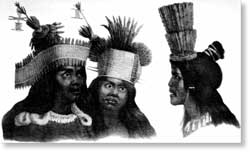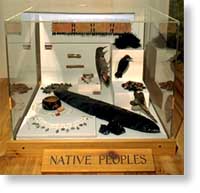








 
|

|
  
California on the Eve -
California Indians
 "As
the Earth filled with water, Coyote got together with Frog to make a place
to live. Frog dove deep and brought up two handfuls of sand. Then Coyote
scattered the sand all around
and created land. Next he created pine nuts and acorns and all the other
kinds of food. When he finished, he said to Frog, ' This is a good earth,
and now I'll create the People
to make it their home'." "As
the Earth filled with water, Coyote got together with Frog to make a place
to live. Frog dove deep and brought up two handfuls of sand. Then Coyote
scattered the sand all around
and created land. Next he created pine nuts and acorns and all the other
kinds of food. When he finished, he said to Frog, ' This is a good earth,
and now I'll create the People
to make it their home'."
— Mountain Miwok creation story

Click icon to hear
Native Peoples
 Look
at these objects and the plants and animals interspersed among them. Indians were
California's first people. Before the Spanish began colonizing the area in 1769, there
were more than 300,000 Indian people here. They represented over 100 tribes, a diverse
collection of societies with distinct cultures and traditions. California's native people
believed they were part of the land itself, part of a harmonious balance with nature. Look
at these objects and the plants and animals interspersed among them. Indians were
California's first people. Before the Spanish began colonizing the area in 1769, there
were more than 300,000 Indian people here. They represented over 100 tribes, a diverse
collection of societies with distinct cultures and traditions. California's native people
believed they were part of the land itself, part of a harmonious balance with nature.
Indian people used what nature had to
offer. G.M. Sandel, an early American settler, observed: The Indians were very well
formed, robust, handsome people. They were partly tattooed, and wore ornaments of bone and
beads. They used bows and arrows and were very expert fishermen. They gathered acorns,
roots, and grass-seed.
Dentalium/not Gold
 Gold has always been in California. Didn't some of California's
Indians know it was here? Of course they knew it was here. It just had no value in their
culture. Certain other items from nature represented value. Dentalium shells were used
both as a medium of exchange and as a sign of wealth. Why would a big chunk of obsidian
have been highly valued? It was used by skilled craftsmen for making knives and arrowheads
that would be used for hunting, or in ceremonies. Gold has always been in California. Didn't some of California's
Indians know it was here? Of course they knew it was here. It just had no value in their
culture. Certain other items from nature represented value. Dentalium shells were used
both as a medium of exchange and as a sign of wealth. Why would a big chunk of obsidian
have been highly valued? It was used by skilled craftsmen for making knives and arrowheads
that would be used for hunting, or in ceremonies.
Seed Beater
California's Indians collected seeds and
acorns, hunted deer and elk, and caught salmon and grasshoppers. Whether the plants and
animals were prepared and eaten as food, or harvested to make essential tools and
ceremonial objects, all were nature's offerings. G.M. Waseurtz, in 1842, observed: They
gathered acorns, roots and grass-seeds . . . Often we fell in with large numbers of
Indians loaded with roots and acorns which they had gathered from afar. They encamped
along side us. The Indians gave us some of their hard bread. It tasted like ginger bread,
and seemed a very healthful food.
 
This seed beater, belonging to the Maidu
tribe, is made out of buck brush. The beater was used to knock seeds from the tops of
grasses into the burden basket. The Indians harvested over thirty kinds of grasses for
food. Lucy Young, a Wailiki, or Wintu Indian woman born around 1846, recalled her  grandfather's prophecy: My grandpa say, 'White
Rabbit'-he mean white people-'gonta devour our grass, our seed, our living. We won't have
nothing more, this world.' grandfather's prophecy: My grandpa say, 'White
Rabbit'-he mean white people-'gonta devour our grass, our seed, our living. We won't have
nothing more, this world.'
European Contact
The arrival of Europeans provoked profound
changes for California Indians. In their missionary zeal, the priests set out to subjugate
the Indian people by exploiting their labor, and changing their traditional culture.
Disease, abuse, and the destruction of their environment spelled disaster. In the first
ten years of the mission system, over sixteen thousand Indians were baptized and over nine
thousand of those died. By 1817, the mortality rate among the mission Indians had risen to
nearly 90 percent. In only 100 years of contact with Europeans and Americans, California's
entire native population had been reduced by ninety percent, a staggering decline.
Top: Flicker Band, Collection of Oakland Museum of
California
Second from top: Natives with Headresses, Collection of Oakland Museum of
California
Third from top: Native Peoples, Christopher Richard
Fourth from top: Seed Beater, Collection of Oakland Museum of California
Fifth from top: Maidu Cooking Basket, Collection of Oakland Museum of California
Bottom: Woodpecker Scalps, Catherine Buchanan
Nature | Californio
| California Indian |
 |


 "As
the Earth filled with water, Coyote got together with Frog to make a place
to live. Frog dove deep and brought up two handfuls of sand. Then Coyote
scattered the sand all around
and created land. Next he created pine nuts and acorns and all the other
kinds of food. When he finished, he said to Frog, ' This is a good earth,
and now I'll create the People
to make it their home'."
"As
the Earth filled with water, Coyote got together with Frog to make a place
to live. Frog dove deep and brought up two handfuls of sand. Then Coyote
scattered the sand all around
and created land. Next he created pine nuts and acorns and all the other
kinds of food. When he finished, he said to Frog, ' This is a good earth,
and now I'll create the People
to make it their home'." Look
at these objects and the plants and animals interspersed among them. Indians were
California's first people. Before the Spanish began colonizing the area in 1769, there
were more than 300,000 Indian people here. They represented over 100 tribes, a diverse
collection of societies with distinct cultures and traditions. California's native people
believed they were part of the land itself, part of a harmonious balance with nature.
Look
at these objects and the plants and animals interspersed among them. Indians were
California's first people. Before the Spanish began colonizing the area in 1769, there
were more than 300,000 Indian people here. They represented over 100 tribes, a diverse
collection of societies with distinct cultures and traditions. California's native people
believed they were part of the land itself, part of a harmonious balance with nature. Gold has always been in California. Didn't some of California's
Indians know it was here? Of course they knew it was here. It just had no value in their
culture. Certain other items from nature represented value. Dentalium shells were used
both as a medium of exchange and as a sign of wealth. Why would a big chunk of obsidian
have been highly valued? It was used by skilled craftsmen for making knives and arrowheads
that would be used for hunting, or in ceremonies.
Gold has always been in California. Didn't some of California's
Indians know it was here? Of course they knew it was here. It just had no value in their
culture. Certain other items from nature represented value. Dentalium shells were used
both as a medium of exchange and as a sign of wealth. Why would a big chunk of obsidian
have been highly valued? It was used by skilled craftsmen for making knives and arrowheads
that would be used for hunting, or in ceremonies.

 grandfather's prophecy: My grandpa say, 'White
Rabbit'-he mean white people-'gonta devour our grass, our seed, our living. We won't have
nothing more, this world.'
grandfather's prophecy: My grandpa say, 'White
Rabbit'-he mean white people-'gonta devour our grass, our seed, our living. We won't have
nothing more, this world.'